The top cities for US job seekers in 2023

Canva
The top cities for US job seekers in 2023
A young couple jointly study a laptop in a kitchen setting.
Amid news of high-profile layoffs, the national unemployment rate is actually relatively low. According to the U.S. Bureau of Labor Statistics, it was just 3.4% in January 2023, a rate comparable to unemployment before the start of the pandemic. It’s still a job seekers’ market, which may inspire some to take the financial risk to move to a new state or city.
Using data from the U.S. Bureau of Labor Statistics and the U.S. Department of Housing and Urban Development, MoneyGeek compared 95 cities with labor forces of at least 300,000 to rank the best and worst places for job seekers in the U.S. in 2023. This analysis looked at five key economic factors to determine the ranking: wage and job growth, unemployment rate, labor force size and housing affordability. In addition to ranking the best and worst cities overall, ranks include the best and worst cities for each of the key economic factors measured. Here’s what we found.
KEY FINDINGS
– Jacksonville, Florida, is the best city for job seekers. The city experienced the highest job growth among all cities analyzed, with a low unemployment rate and wage growth triple the national average.
– The worst city for job seekers is Akron, Ohio — stagnant job growth and declines in average wages put this city at the bottom of our ranking.
– 6 of the 10 best cities for job seekers are in Florida: high job and wage growth make these cities desirable for job seekers.
– Provo, Utah, is the best city for Gen Z job seekers — there, this generation makes up 16.4% of the population, job growth is high and competition is low.
– Palm Bay, Florida, had the highest wage growth of all cities analyzed at 6.3%, contributing to its ranking as the No.7 best city for job seekers overall.
![]()
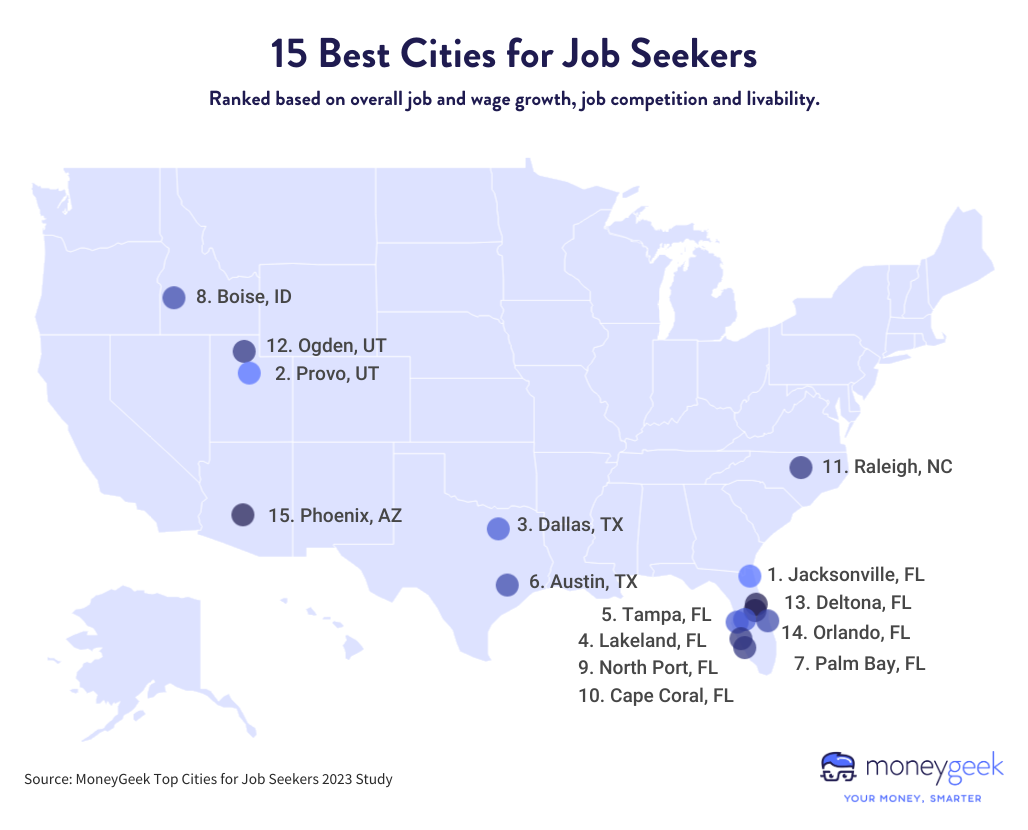
MoneyGeek
15 best cities for job seekers
A U.S. map showing the 15 best cities for job seekers.
MoneyGeek analyzed 95 of the largest cities in the United States to find the best and worst places for job seekers in 2023. We looked at each community’s growth in employment during the last 12 months and for the previous three years, growth in hourly wages over the last 12 months, current unemployment rate, current labor force size and average monthly wage over monthly rent ratio to determine our rankings. The most important factors — including growth in employment during the last 12 months and three years and growth in hourly wages — were double-weighted (22%), while the other factors each contributed 11%.
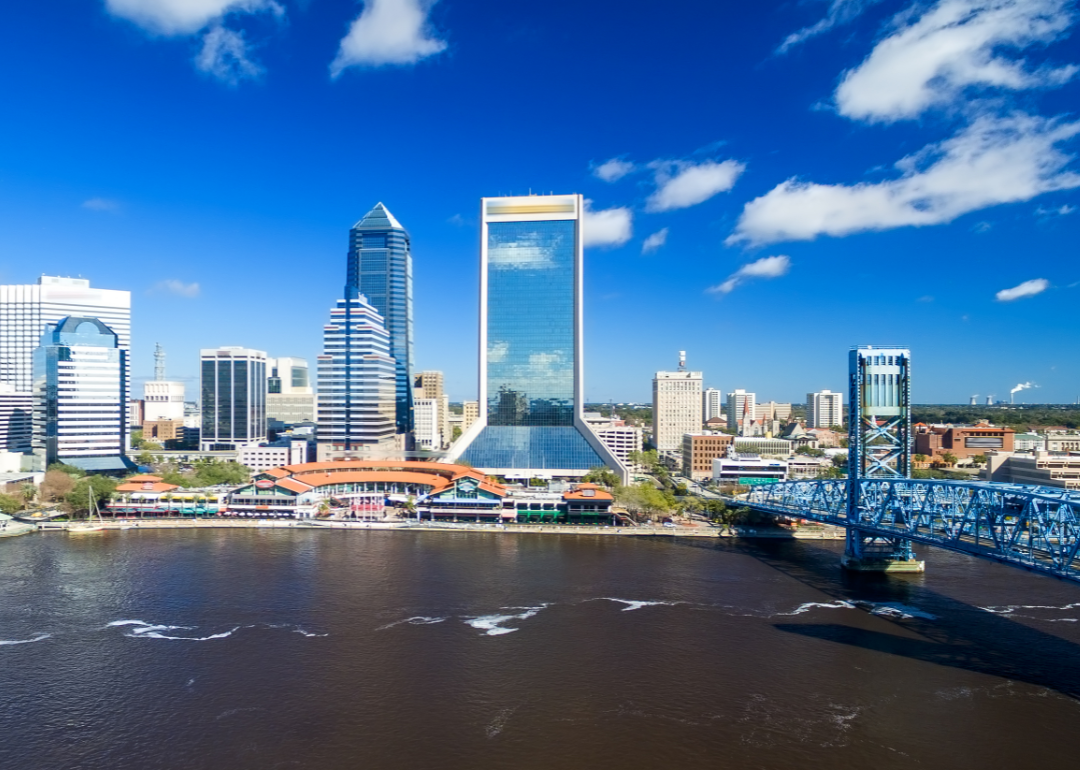
Canva
Best cities for job seekers in the US
A view across the water of the Jacksonville, Floirida, skyline.
The best cities for job seekers have impressive job and wage growth, low job competition and affordable housing prices; in other words, they provide solid employment opportunities and low-cost living.
TOP 15 CITIES FOR JOB SEEKERS IN 2023
1. Jacksonville, FL – Score: 99.0
2. Provo, UT – Score: 95.8
3. Dallas, TX – Score: 93.1
4. Lakeland, FL – Score: 90.1
5. Tampa, FL – Score: 87.8
6. Austin, TX – Score: 84.5
7. Palm Bay, FL – Score: 84.5
8. Boise City, ID – Score: 82.7
9. North Port, FL – Score: 80.4
10. Cape Coral, FL – Score: 79.0
11. Raleigh, NC – Score: 76.0
12. Ogden, UT – Score: 76.0
13. Deltona, FL – Score: 75.1
14. Orlando, FL – Score: 74.6
15. Phoenix, AZ – Score: 73.1
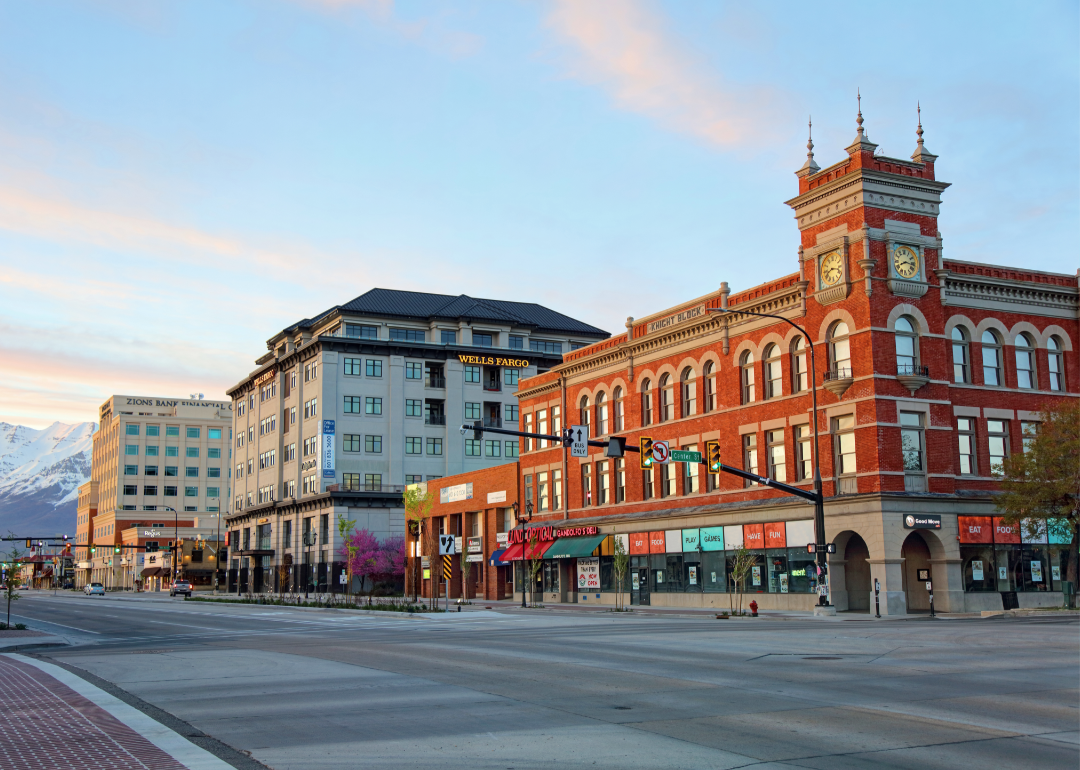
Canva
Best cities for Gen Z job seekers
A street in downtown Provo, Utah.
Among the best cities for job seekers, we found that some of the top cities for jobs, livable wages and opportunity also had a higher-than-average concentration of Gen Z residents. Of the cities we analyzed, Gen Zers constituted 9.1% of the population, on average. Below are the five cities ranked in the 20 best cities that also have an above-average Gen Z population; these could be excellent places for young people new to the job market to find opportunity and community.
TOP 5 CITIES FOR GEN Z JOB SEEKERS IN 2023
1. Provo, UT | Score: 95.8 | Gen Z Population: 16.4%
2. Austin, TX | Score: 84.5 | Gen Z Pop: 9.3%
3. Ogden, UT | Score: 76.0 | Gen Z Pop: 9.5%
4. Riverside, CA | Score: 71.9 | Gen Z Pop.: 9.6%
5. Salt Lake City, UT | Score: 70.8 | Gen Z Pop: 9.6%
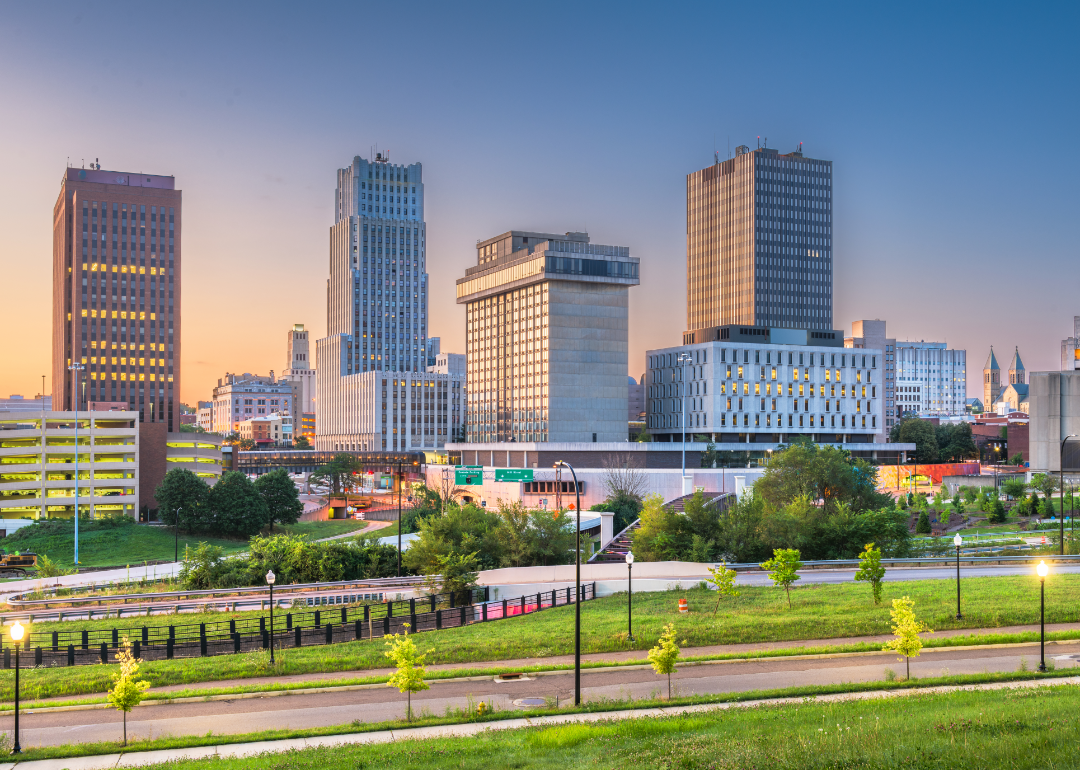
Canva
Worst cities for job seekers in the US
A distant view of the Akron, Ohio, skyline.
While the top cities on our list are affordable, growing and relatively uncompetitive, the worst cities for job seekers tend to have slower wage and job growth, less affordable housing relative to income and competitive job markets. These 15 cities ranked the lowest on our list. Notably, Ohio cities have three entries in the bottom of the list.
WORST CITIES FOR JOB SEEKERS IN 2023
1. Akron, OH – Score: 1.0
2. Bridgeport, CT – Score: 5.7
3. Worcester, MA – Score: 7.0
4. Urban Honolulu, HI – Score: 9.4
5. Milwaukee, WI – Score: 12.0
6. Oxnard, CA – Score: 19.3
7. San Francisco, CA – Score: 19.7
8. New York, NY – Score: 20.5
9. Los Angeles, CA – Score: 20.5
10. Cincinnati, OH – Score: 22.1
11. Boston, MA – Score: 23.7
12. Richmond, VA – Score: 24.7
13. Hartford, CT – Score: 24.7
14. Providence, RI – Score: 24.7
15. Dayton, OH – Score: 24.8

Canva
Factors that make a city ideal for job seekers
Residential buildings in the foreground and office buildings in the background of a cityscape.
MoneyGeek ranked the best and worst cities using four key factors — job growth, wage growth, unemployment rate and housing-to-income ratio — to better understand which cities best served those seeking employment and which fell flat. These factors all contribute to what makes a city attractive or less-than-ideal for job seekers; many cities excel in some areas but fall short in others.
To better understand how well or poorly cities performed in each of our ranking categories, MoneyGeek found the best (and worst) cities for each category. You can find those rankings — along with a brief description of their significance — below.
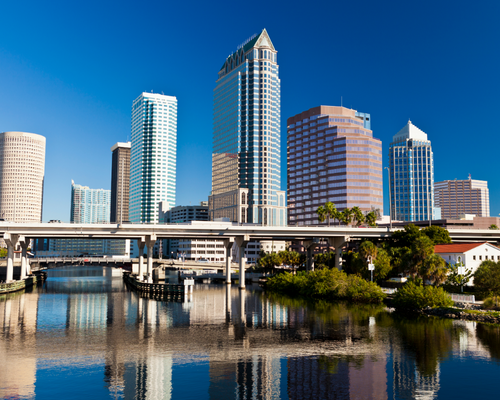
Canva
Job growth over the last 12 months
A daytime view of the Tampa skyline in Florida.
In 2023, the majority of the best cities for job growth in the last 12 months are concentrated in Florida, while 4 of the 5 worst cities for job growth are in the Midwest.
BEST CITIES FOR JOB GROWTH
1. Jacksonville, FL (5.6%)
2. Tampa, FL (5.4%)
3. Orlando, FL (5.2%)
4. Las Vegas, Nevada (5.1%)
5. Riverside, CA (5.0%)
WORST CITIES FOR JOB GROWTH
1. Milwaukee, WI (-1.7%)
2. Madison, WI (-1.1%)
3. Columbia, SC (-0.7%)
4. Cincinnati, OH (-0.6)%
5. Akron, OH (-0.5%)
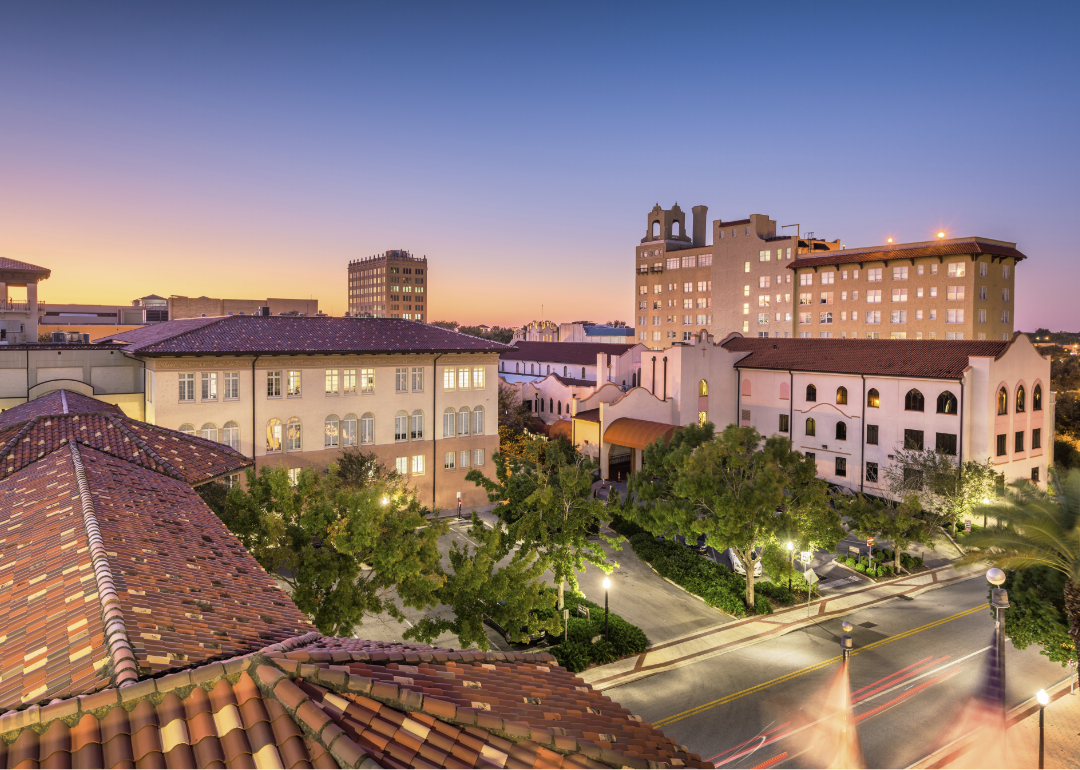
Canva
Wage growth over the last 12 months
A view from above of several buildings at sunset in Lakeview, Florida.
When wages grow, a city is doing something right. Palm Bay, Florida’s 12-month wage growth tops MoneyGeek’s list with 6.3% wage growth. Meanwhile, San Francisco, California, experienced a 12.2% wage decline since 2022.
BEST CITIES FOR WAGE GROWTH
1. Palm Bay, FL (6.3%)
2. Lakeland, FL (5.6%)
3. Cape Coral, FL (5.2%)
4. Deltona, FL (4.7%)
5. Ogden, UT (4.4%)
WORST CITIES FOR WAGE GROWTH
1. San Francisco, CA (-12.2%)
2. San Jose, CA (-8.4%)
3. New York, NY (-7.4%)
4. Bridgeport, CT (-6.8%)
5. Boston, MA (-3.9%)

Canva
Unemployment rate
A distant view of the Salt Lake City skyline early in the day.
Naturally, it’s a good sign for a job seeker if you see a city with low unemployment; ultimately, it means your odds of being hired at a new job should be pretty good. Provo, Utah, is MoneyGeek’s standout in this category, with just 2% unemployment.
CITIES WITH THE LOWEST UNEMPLOYMENT RATES
1. Provo, UT (2.0%)
2. Ogden, UT (2.1%)
3. Salt Lake City, UT (2.2%)
4. Miami, FL (2.2%)
5. Minneapolis, MN (2.2%)
CITIES WITH THE HIGHEST UNEMPLOYMENT RATES
1. Bakersfield, CA (7.2%)
2. McAllen, TX (7.0%)
3. Fresno, CA (6.4%)
4. Las Vegas, NV (5.6%)
5. Stockton, CA (5.4%)
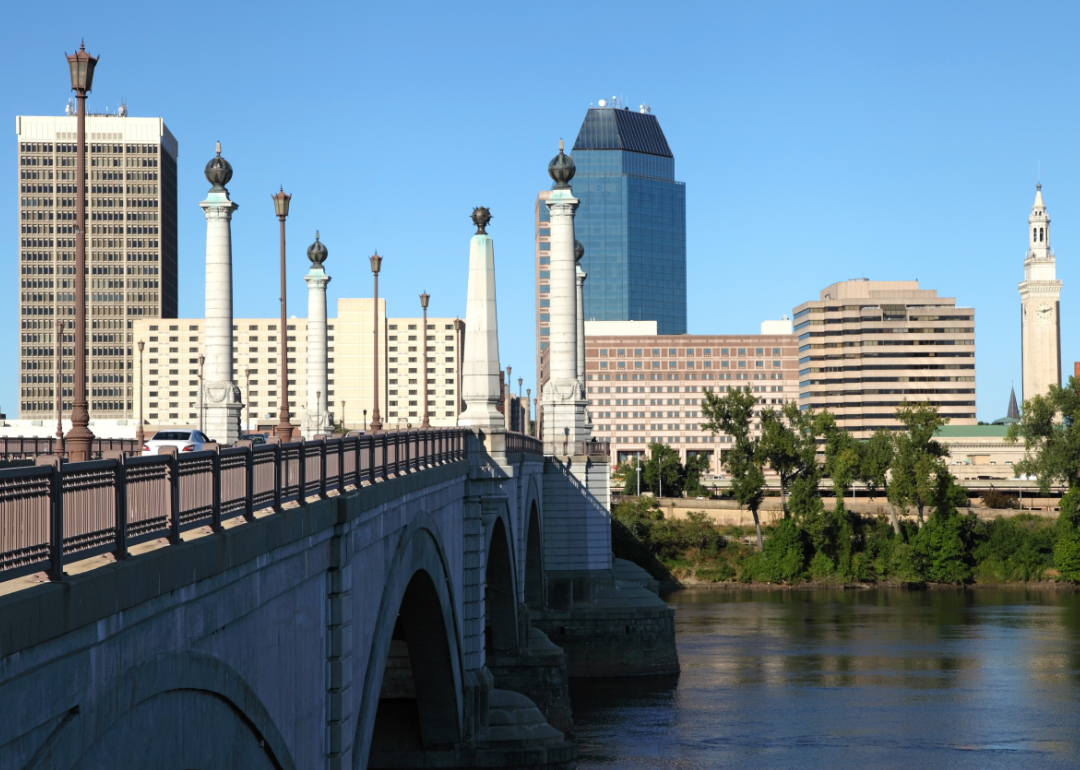
Canva
Housing-to-income ratio
A bridge leads across a river into downtown Springfield, Massachusetts.
A city’s housing-to-income ratio roughly translates to its affordability; the less money you spend on rent and housing compared to your overall income, the more money you have for everything else. That’s why your money goes much further in Springfield, Massachusetts, than in more expensive cities like Oxnard, California, or Honolulu, Hawaii. In Springfield, monthly rent costs just under 22% of your income, on average. After paying for housing in Oxnard or Honolulu, you’ll have to spend more than half of your income on housing and be left with the other half to cover all other expenses.
CITIES WITH THE BEST HOUSING-TO-INCOME RATIOS
1. Springfield, MA (21.9%)
2. Cleveland, OH (22.2%)
3. St. Louis, MO (22.5%)
4. Toledo, OH (22.9%)
5. Dayton, OH (23.3%)
CITIES WITH THE WORST HOUSING-TO-INCOME RATIOS
1. Oxnard, CA (54.1%)
2. Urban Honolulu, HI (51.7%)
3. Providence, RI (48.9%)
4. Los Angeles, CA (47.7%)
5. San Diego, CA (46.0%)

Canva
Financial tips for job seekers
A couple in the background have a discussion while the foreground is filled with moving boxes.
Relocating to a new city to find a job can be time-consuming and expensive, especially if this isn’t a cross-town journey and you’re moving out of state. If you’re going to move to a new city without having a job lined up, we recommend considering the following:
Ensure you have adequate savings.
Start saving as much as possible to ensure you have a financial safety net in your new city. After all, you may move somewhere the jobs are plentiful, but the interview process could take longer than you imagine. A robust savings account also means you can be choosier about the jobs you pick, and you’ll have something to sustain you if your first job doesn’t last long.
Try not to rely too much on credit cards.
Yes, credit cards are an indispensable cash flow tool and, if you have a credit card with rewards, an excellent way to make money. Use your credit cards well, and those cash back rewards could mean significant savings on your purchases. But if you move somewhere without a job and don’t find employment immediately, the credit card debt you’re accruing could eventually mean that much of your future paycheck will be devoted to paying off revolving debt.
Research your new city and make a plan.
As in, figure out where you may live. Will you start off in a hotel or an apartment complex? Or somewhere in between? Have you used a cost of living calculator to crunch the numbers and see what it will cost you to live there, including things like getting your car and car insurance to a new state? Switching car insurance when you cross state lines can make a lot of sense. The more information you have, the better you’ll feel about your decision.
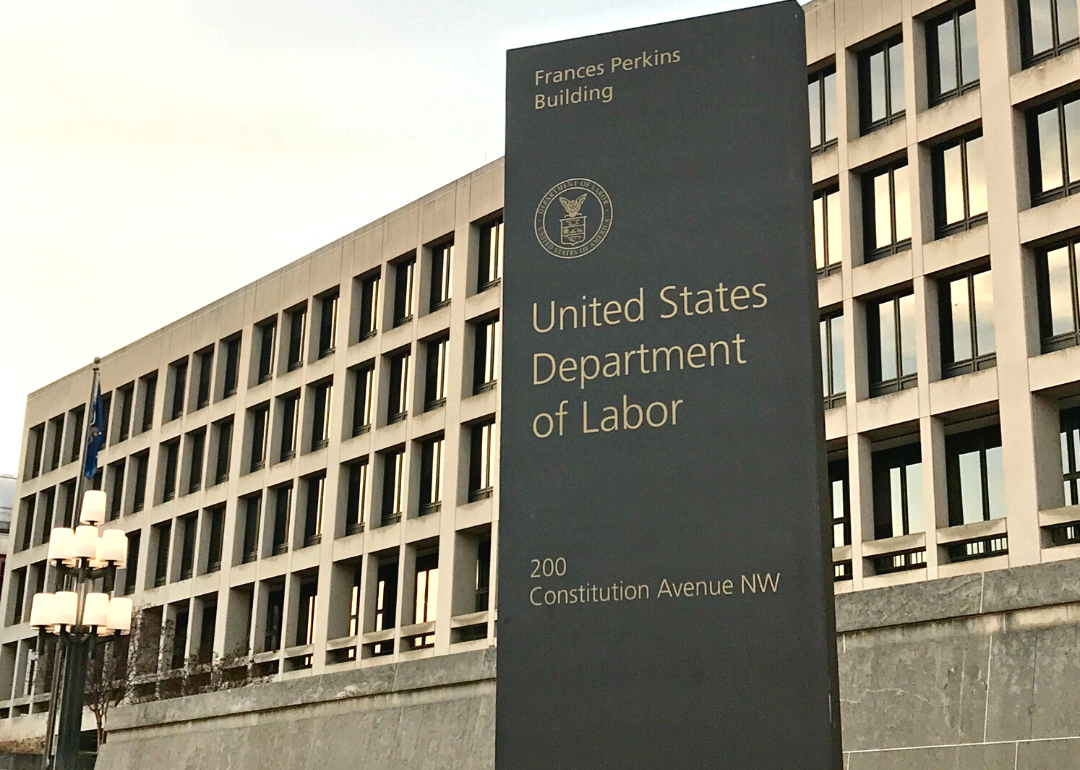
DCStockPhotography // Shutterstock
Methodology
An exterior shot of the United States Department of Labor headquarters.
To rank the best cities for job seekers, MoneyGeek calculated three factors using earnings data and employment statistics from the U.S. Bureau of Labor Statistics and median rent rates reported by the Department of Housing and Urban Development to estimate how good a city is for someone seeking jobs. We analyzed data for 95 cities with labor forces of at least 300,000 across the U.S.
The first factor we calculated is overall growth, which incorporates the trends in jobs created and trends in wages.
The next consideration is job competition, which includes the unemployment rate and the overall size of the employment numbers reflecting greater absolute availability of jobs.
The final factor is housing affordability, which captures the ratio of wages over rents to indicate an area’s cost of living.
Additionally, MoneyGeek used 2021 U.S. Census Bureau data to analyze which cities had a higher-than-average population of Generation Z residents for job-seeking new college graduates.
MoneyGeek used the following metrics in our analysis:
– Growth in employment, last 12 months: 22% weight (double weight)
– Growth in employment, last three years: 22% weight (double weight)
– Growth in hourly wages, last 12 months: 22% weight (double weight)
– Unemployment rate, current: 11% weight (full weight)
– Size of labor force: 11% weight (full weight)
– Monthly wages over monthly rents ratio: 11% weight (full weight)
The individual factors were ranked as follows:
– Overall Growth: Growth in employment over the last 12 months (44% weight), growth in employment over the last 36 months (22% weight), hourly wage growth in the last 12 months (33% weight). In the overall ranking, this is 45% of the overall weight.
– Job Competition: Unemployment rate (78% weight) and size of the labor force (22% weight). In the overall ranking, this is 45% of the overall weight.
– Housing Affordability: Wages over rents ratio (100% weight). This is 10% of the overall weight.
– For the purposes of this analysis, only metropolitan statistical areas (MSAs) with labor forces of at least 300,000 were considered in the ranking.
SOURCES
U.S. Bureau of Labor Statistics. “The Employment Situation — January 2023.” Accessed February 28, 2023.
U.S. Bureau of Labor Statistics. “State and Metro Area Employment, Hours, & Earnings.” Accessed February 2, 2023.
United States Census Bureau. “Explore Census Data.” Accessed February 2, 2023.
U.S. Department of Housing and Urban Development. “50TH PERCENTILE RENT ESTIMATES.” Accessed February 2, 2023.
This story originally appeared on MoneyGeek and has been independently reviewed to meet journalistic standards.